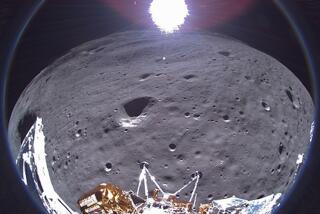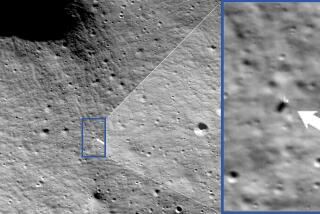Mars landing: Do-or-die time for Curiosity rover; it’s on its own
- Share via
With just over 24 hours till the “seven minutes of terror” -- when Mars rover Curiosity makes its unprecedented, hellbent-for-leather descent to the surface of Mars -- the NASA rover team sits and waits. And, perhaps, paces.
After a command sent a few days ago, “we literally could do nothing more,” says the Jet Propulsion Laboratory’s Ashwin Vasavada.
That was when the Curiosity team sent a directive zooming through space -- 35 million miles or so -- to Earth’s latest ambassador to Mars, telling it to put its plan into action.
PHOTOS: A closer look at the mission and the rover
“We sent a command to the spacecraft to start its onboard program to execute the final approach, entry, descent and landing,” Vasavada told the Los Angeles Times in an interview late Friday. “We literally could do nothing more, and the spacecraft will land itself.”
On Thursday, mission project manager Pete Theisinger told The Times that things were quiet -- eerily so. “I’m waiting for the other shoe to drop.”
A dust storm was causing scientists some concern Thursday, and a dust storm on Mars is no small worry. In April, NASA photographed a massive dust devil that extended from the surface of the Red Planet 12 miles up into the atmosphere.
INTERACTIVE: From liftoff to landing
At the time, Vasavada, deputy project scientist with the Mars Science Laboratory at JPL, called the size of the Mars dust devil “unique.”
As the sun beats down on the desert-like surface of Mars, he explained, convection begins. “Conditions allowed this single giant vortex to form and survive,” he said.
The current dust storm has been swirling south of the intended landing site of Curiosity -- about 600 miles away. But despite the distance, the size means it could create a worrisome cloud of dust at the landing site.
Still, the rover was engineered to be able to fend off Mars’ nasty weather, Theisinger said -- save a “great-grandmother of all storms.”
Early last month, NASA released a video of the final minutes of the Mars rover landing that stirred space fans’ interest in a dramatic fashion. “Seven Minutes of Terror” has a thrumming soundtrack and the feel of a movie preview. The “Terror” video spotlights the unprecedented nature of the landing -- it’s a procedure unlike any ever attempted. Here, briefly, is what has to happen:
1) The spacecraft’s heat shield has to withstand temperatures of 1,600 degrees Fahrenheit as the craft enters Mars’ atmosphere and slows from its entry speed of 13,000 miles per hour.
2) The supersonic parachute must work. Several miles above the surface of the planet, the parachute must pop open while the spacecraft is still moving at almost twice the speed of sound.
3) Curiosity must emerge from the shell attached to the parachute, with rockets blazing, to further slow the descent speed.
4) In what’s called the “Sky Crane maneuver,” the rover must successfully be lowered via cables.
NASA scientists have continually expressed a sunny confidence in their ability to accomplish this feat. But now it’s do-or-die time, with the rover set to land at 10:30 p.m. Sunday.
There’s a 14-minute time lag for all radio signals traveling from Mars to Earth, Vasavada said in an earlier interview. That’s how long the hundreds of scientists involved in the project will have to wait to find out if something occurred to kill their mission.
Can 700 scientists hold their breath for 14 minutes?
ALSO:
Found on Mercury: Mickey Mouse
Play along with ‘7 Minutes of Terror’ on Xbox
Here’s the man responsible for messing up the Mars mission
Join Amy Hubbard on Google+
More to Read
Sign up for Essential California
The most important California stories and recommendations in your inbox every morning.
You may occasionally receive promotional content from the Los Angeles Times.











